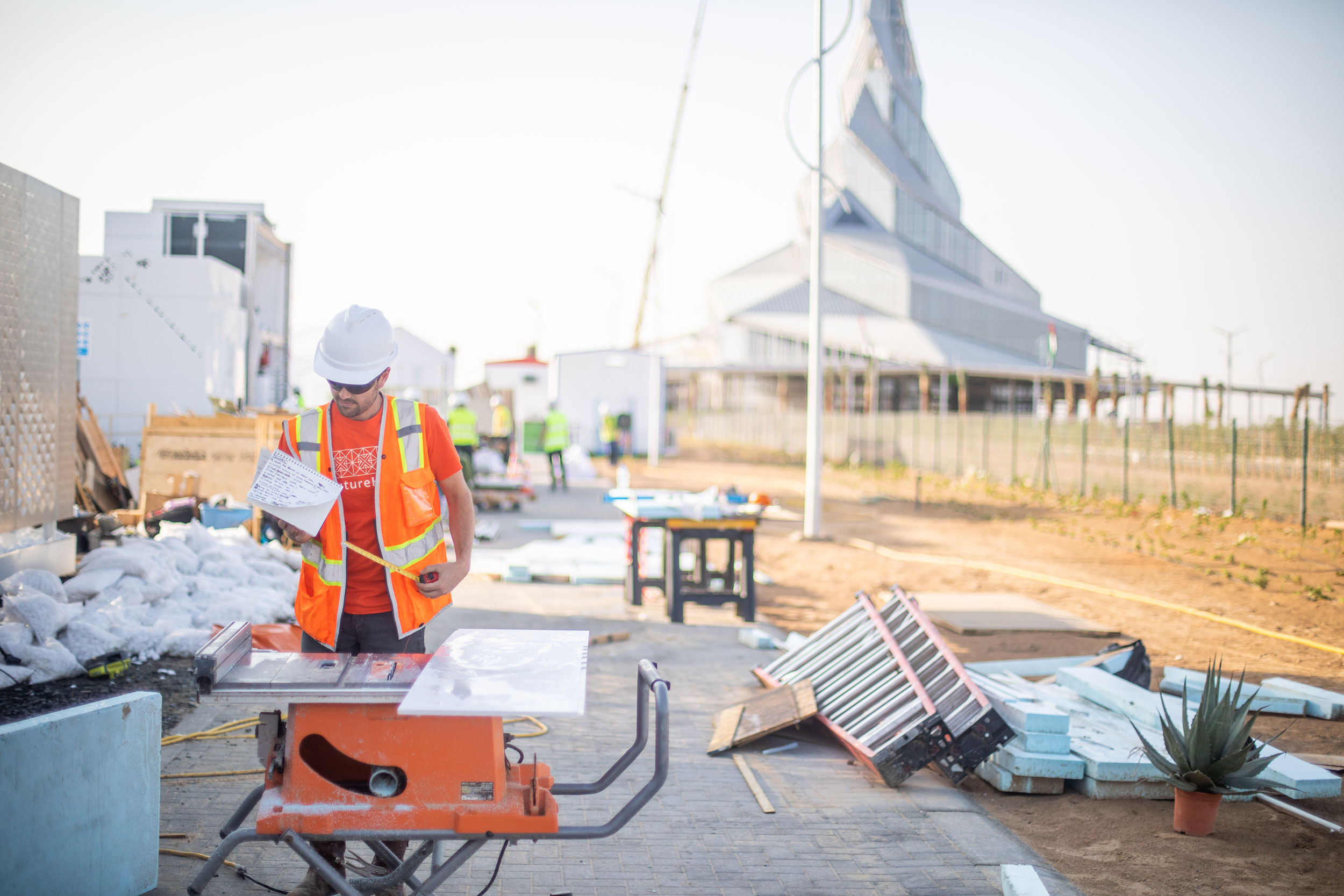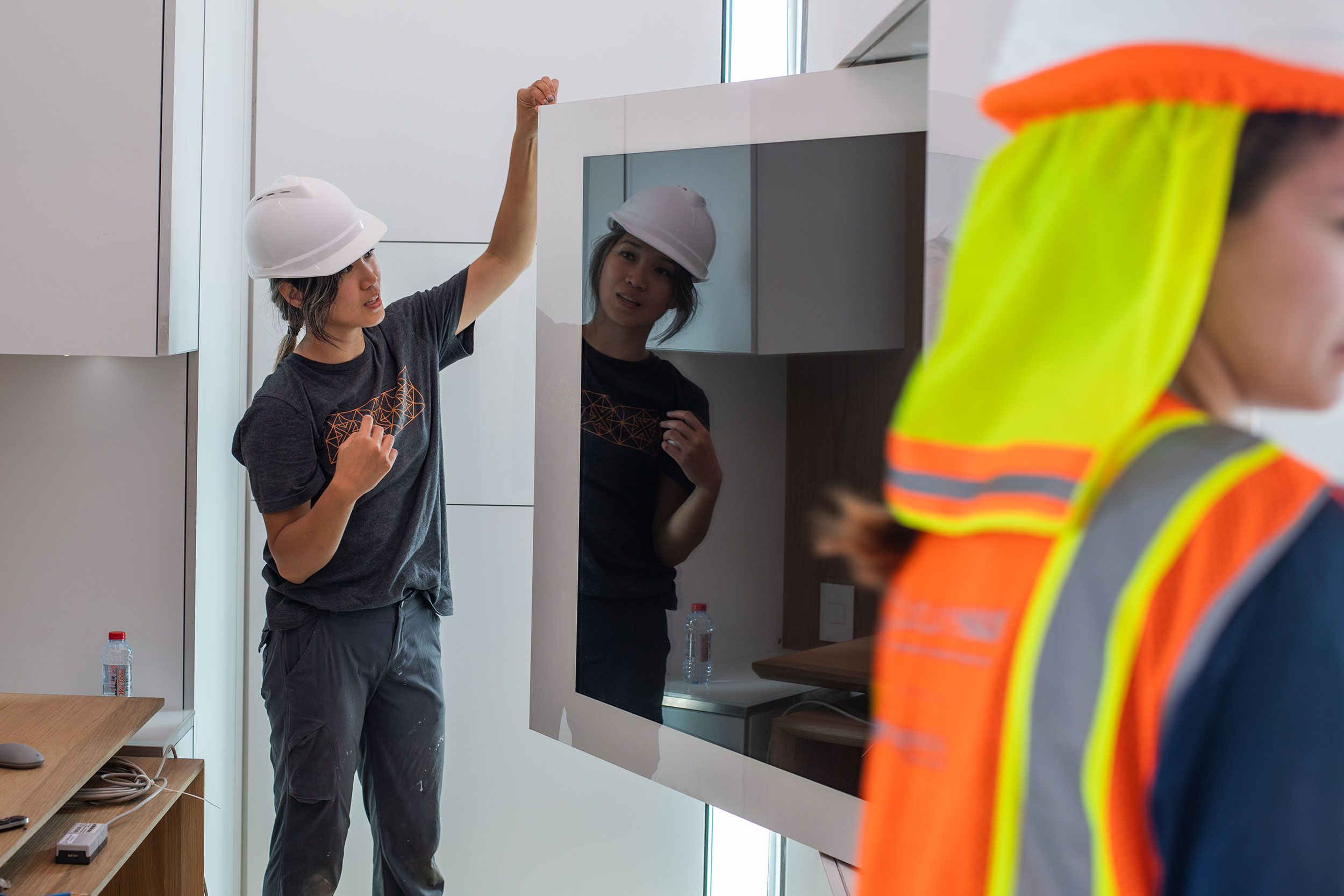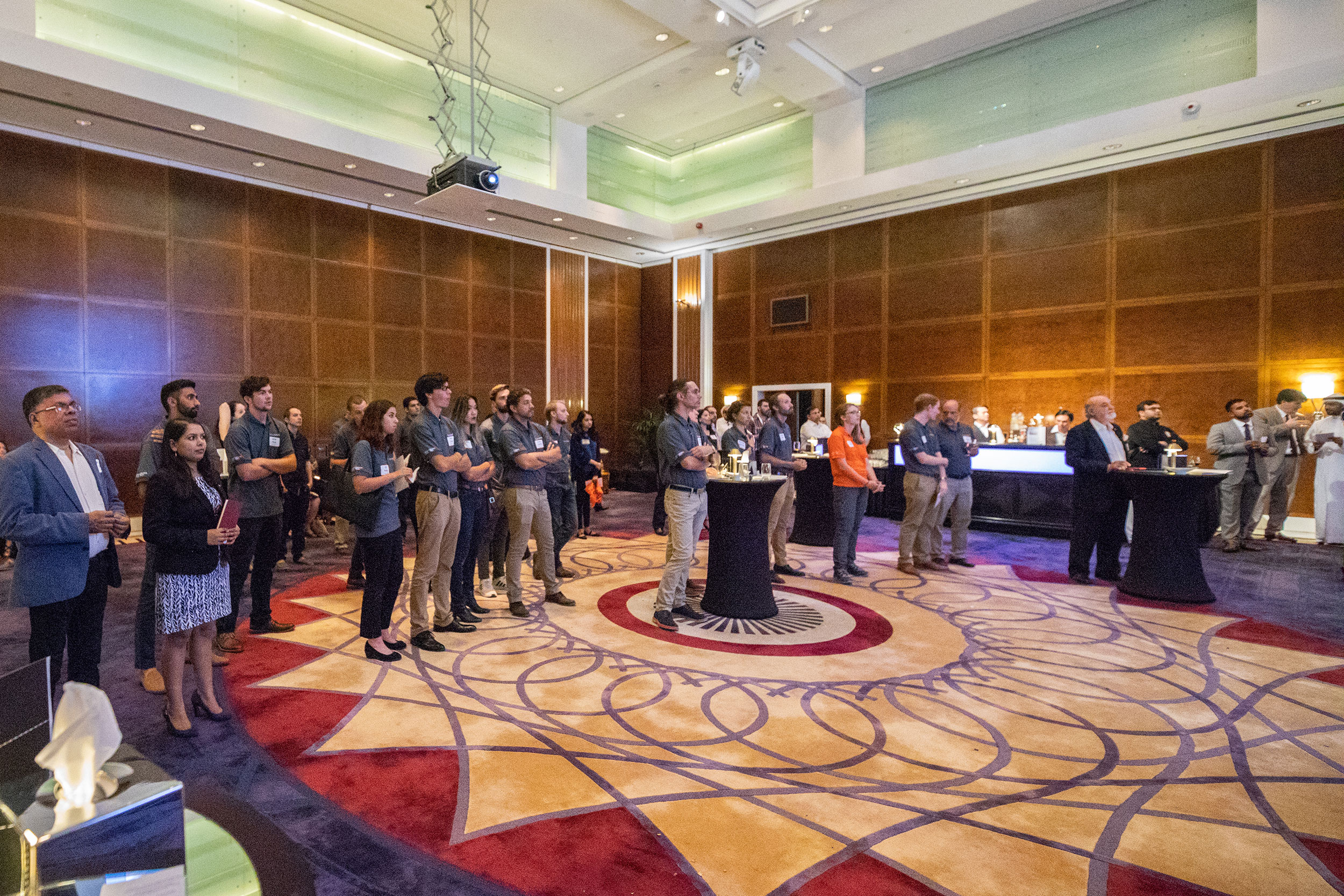by Erica Corder and Travis Williams
Nearly 150 years have passed since the first student enrolled at Virginia Tech. The needs of the world have shifted. Technology has advanced, and the demand for creative problem-solving has grown exponentially. In 2019, our world-class faculty engages with students not only inside traditional classrooms, but also in swamps, urban neighborhoods, and across international boundaries. Students collaborate across the academic spectrum, creating the future through projects that target real-world challenges, such as energy-efficient home design and quality construction.
How did Virginia Tech’s FutureHAUS rise from the ashes to climb to the pinnacle of design for the world’s solar homes?
The task wasn’t easy, but the team succeeded by building on the very foundation of the university’s vision for the future, Beyond Boundaries. The project unites students and faculty from various colleges and disciplines in building a net-zero energy home incorporating new methods of prefabrication, technology, and sustainability.
“We have the most interdisciplinary team that we’ve ever had around any research project, and that’s what it takes. That’s the secret,” said Joe Wheeler, architecture professor and lead faculty of FutureHAUS Dubai. “That’s the formula to making something this amazing.”
In November 2018, following months of hard work and years of study, the FutureHAUS Dubai team earned first place in the 2018 Solar Decathlon Middle East, a competition to accelerate research on building sustainable, grid-connected solar homes launched by the United States Department of Energy and the United Arab Emirates’ Dubai Electricity & Water Authority. The lone American entry, the Hokie-built 900-square-foot home outranked 14 teams selected from a pool of 60 entrants.

Beginning the assembly work.
The win is the culmination of nearly two decades of research, two years of accelerated development after the previous iteration was destroyed in a 2017 fire, and more than a month spent in a desert near Dubai erecting the structure.
In addition to achieving first place overall, the FutureHAUS Dubai team landed in the top three in nearly all sub-contests earning: first place honors in architecture and creative solutions, second place in energy efficiency and interior design, and third place in sustainability and in engineering and construction.
Moving FutureHAUS Dubai from concept to reality was a university-wide effort. Virginia Tech’s College of Architecture and Urban Studies, College of Engineering, Myers-Lawson School of Construction, Pamplin College of Business, College of Liberal Arts and Human Sciences, and the College of Science, as well as various centers and labs across campus contributed to the success of the project.
Team members said they knew that bringing together talents and experience across the university would be critical to their success.

Measure twice, cut once.
“It’s the reason why we have computer science, engineering, landscape architecture, interior design, architecture—we have people from all different backgrounds,” said Josh Delaney, a first-year master’s student who worked in the construction industry prior to enrolling in the architecture program. “I bring the real-world building experience.”
The collaboration, which not only involved the team members on the ground in Dubai, but also those who remained in Blacksburg, was a unique opportunity for many of the students.
“I have never experienced this much interdisciplinary knowledge going back and forth every single day to get something done,” said Michelle Le ’18, who was a student architectural design leader for the team. “Learning how to work together and working almost as a big family to get something like this into fruition—I think it was just incredible.”
Living in the future
The FutureHAUS Dubai team was tasked with creating the house of the future—a home that serves the needs of an aging population, addresses growing environmental concerns, and integrates secure smart systems for an increasingly connected but security-concerned population.
The house was equipped with 67 devices, including touch screen control panels, automatic sliding doors, a smart mirror to help users find their clothes, and a moveable wall to adjust floor plans using what the team calls “flex space.” The prototype also includes a sink created in collaboration with Kohler, one of the team’s many industry partners, that can deliver precisely measured water for drinking or cooking.

A. Student checks the operation of the big screen.
Creating and implementing the technology assets provided students, such as electrical engineering senior Matt Tucker, with a chance to use what he’s learned in the classroom to solve a real-world problem.
“Not only have I had the opportunity to actually put a lot of this stuff into practice, a lot of it is stuff I get to design,” Tucker said. “So, I get to have input. I’m not just following a textbook or class curriculum.”
The cutting-edge innovations extended to the home’s garden, but rather than implementing even more technology, the team leaned on its landscape architecture students for a different approach. To adhere to the competition’s strict water usage regulations, master’s students Alexandra Schiavoni and Alex Darr incorporated native plants, including four 35-year-old olive trees, that could withstand the intensity of the desert heat.
Crossing traditional academic boundaries to solve complex problems, which is central to Virginia Tech’s vision, drew in many of the team’s key players.
It engaged Megan Dolbin-MacNab, an expert on intergenerational family relationships from the College of Liberal Arts and Human Sciences, to work with aging-in-place accessibility.
It drew in the marketing and business majors who helped tell the story of FutureHAUS Dubai through PRISM, a student-run advertising agency at Virginia Tech.
It attracted students studying industrial and systems engineering in the College of Engineering who worked for a year to determine the most efficient method of shipping the house the 7,286 miles from Blacksburg to Dubai.
And it lured in electrical engineers and researchers from the Center for Power Electronics who built an energy system so efficient that the house can sell energy back to the grid.
Utilizing individual strengths and expertise for a unified purpose, FutureHAUS is a true representation of the positive change possible through collaboration.
Building the future of building
The current rendition of FutureHAUS grew from the successes of a previous generation of structures. The first FutureHAUS, unveiled room by room over five years in international trade shows, burned in a fire at the Environmental Systems Laboratory at the Prices Fork Research Complex in February 2017, just one month after the team completed the full suite of components for the home. One of FutureHAUS’ predecessors, LumenHAUS, won the international Solar Decathlon Competition in Madrid, Spain, in 2010 and is currently on display behind Cowgill Hall. (See related story.) For FutureHAUS Dubai, researchers merged the best features of both, and students turned to crowdfunding to help finance the effort.
The team’s victory in Dubai not only validates their vision for the home of the future, but also their vision for a new way to tackle the housing needs of an increasingly crowded world with finite resources.
Distance learning

Alumna Katherine Lelia Hall has learned that no matter how far from Blacksburg her career takes her, she’s never far from a fellow Hokie.
That sense of global community was reaffirmed at the first Hokies in the Middle East alumni networking event in Dubai, United Arab Emirates. An initiative of the Language and Culture Institute, with support from Alumni Relations and the College of Architecture and Urban Studies, the event brought together more than 85 alumni, students, and supporters.
In addition to connecting with fellow Hokies, alumni got an inside look at FutureHAUS, “We were as proud of the FutureHAUS team as if we ourselves were beside them as they developed the house,” said Hall, who earned a master’s degree in English in 1998 and a doctorate in curriculum and instruction in 2001 and now teaches at Khalifa University in Abu Dhabi.
“We have always believed in this concept, but now the world believes in this concept as well,” said Laurie Booth, a fourth-year architecture student and a student team lead of FutureHAUS Dubai. “[The concepts proposed by FutureHAUS], now that we’ve built it, seem very real, seem very possible, which excites me the most: that maybe someday, thousands of people could live in a house like this.”
Traditionally, building a home requires an on-site construction process, which is subject to uncontrollable factors, such as weather. FutureHAUS, however, was built entirely in a lab as separate but compatible “cartridges” that are equipped with the walls, floors, ceiling, wiring, plumbing, and finishes.
The all-in-one customizable cartridges can be shipped to a location—in the case of Solar Decathlon Middle East, on only five trailers—and easily assembled with a plug-and-play approach.
“Our vision for this house will eventually be to create it on a mass production scale. Just like Henry Ford came and revolutionized the automobile industry by creating assembly lines and mass production techniques, we’re hoping that something similar can happen with this house,” said Rachel Carie ’18, an industrial and systems engineering graduate.
The efficiency of this modular, prefabricated building process paid off for the team during the Solar Decathlon. Virginia Tech was the first team to erect their structure, the first to connect their home to the communications networks, and the first to connect to the power grid on site. The team was one of seven teams awarded bonus points for completing all required inspections by the end of the two-week construction period.
If implemented, the cartridge method could also reap dividends for the homebuilding industry. Homes could be built in mass quantities for lower costs and with greater energy efficiency.
Tradespeople like inspectors, electricians, and plumbers could work at a single location, converging disciplines constantly throughout the homebuilding process and yielding a better product.
That drive for innovation has led several companies, including such top sponsors as Dupont, Dominion Energy, and Kohler, to partner with Virginia Tech’s team, using the house as a test bed for future projects.
“The house reflects a tremendous amount of thought and work, all kinds of details and all kinds of innovations,” said David Christian ’76, former executive vice president and chief innovation officer of Dominion Energy and also a mechanical engineering alumnus who spent the last week of the competition with the team in Dubai.

Showing off the house.
“Dominion is an innovative company, and becoming even more innovative as we speak, so participating in a project like this—it’s just a double benefit,” Christian said.
Such involvement has cultivated relationships that are beneficial to industry partners and Virginia Tech.
“At the university, we cannot propose the future of building without collaboration with industry,” said Wheeler, also a co-director of the Center for Design Research in the School of Architecture + Design. “At the same time, the industry is going to have a hard time proposing what the house of the future is because they’re kind of stuck into a business model that has to generate profit.”
With the competition behind them, the team has high hopes for what lies ahead. They’ve already begun researching methods to scale up production, and a new team of industrial and systems engineering students is exploring a facility concept for manufacturing the houses.
For the immediate future though, members say they’re happy to spend a little time reflecting on what they were able to accomplish together.
“Every time I think about this project, I just can’t help but be amazed by my peers and that we did this,” Booth said. “I just feel forever grateful to the people that were on this project.”
